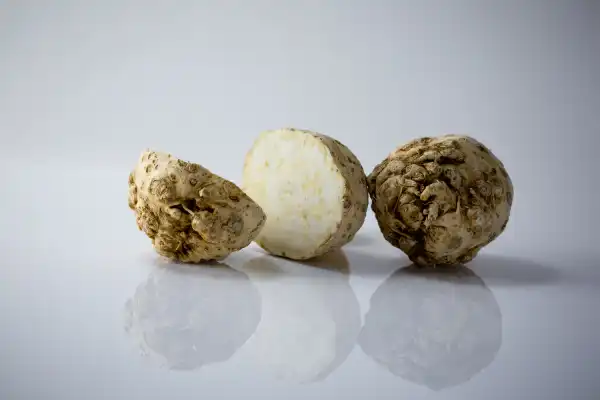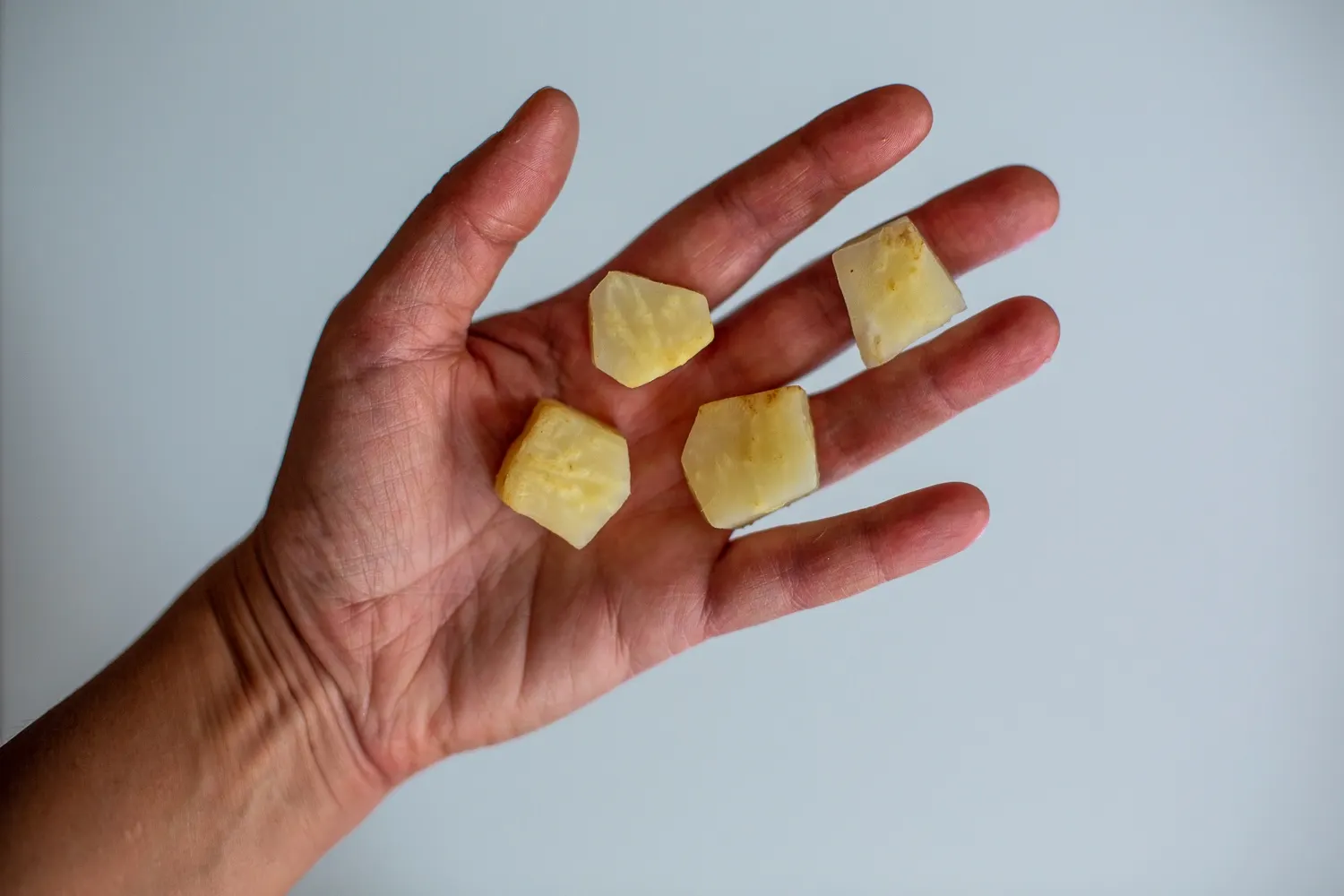Acceda a la base de datos First Foods® en Solid Starts App.
Leer másCeleriac (Celery Root)
Vegetal
Sugerencia de edades
6 meses
Alto contenido de hierro
No
Alérgeno común
No

When can babies have celeriac?
Celeriac may be introduced as soon as baby is ready to start solids, which is generally around 6 months of age.
Celeriac is a variety of celery that comes from the fertile lands around the Mediterranean Sea, where it was cultivated as a medicinal plant in ancient times. Also known as celery root, juurseller, kereviz, and rotselleri, celeriac’s knobby, bulbous stem has rough, hairy skin that can be peeled away to cook the interior flesh, which has the creamy consistency of a potato. In fact, celeriac is often treated like a potato in its native region: fried, grated, mashed, roasted, or mixed into hearty, savory stews, salads like celerie remoulade, and braises like zeytinyagli kereviz.
How do you serve celeriac to babies?
Cada bebé se desarrolla a su propio ritmo, y las sugerencias que ofrecemos sobre cómo cortar o preparar determinados alimentos son generalizaciones para una amplia audiencia.
6 months old +:
Offer large peeled and cooked wedges or sticks about the size of two adult fingers pressed together for baby to munch on, or cooked and mashed celeriac for baby to scoop. The celeriac should be soft enough that it mashes readily when pressed between thumb and pointer finger. You can also serve raw grated celeriac stirred into other soft, scoopable foods like yogurt.
9 months old +:
Serve bite-sized pieces of peeled and cooked celeriac for baby to pick up with their developing pincer grasp (where the thumb and index finger meet). The celeriac should be soft enough that it mashes readily when pressed between thumb and pointer finger. You can also continue serving larger cooked wedges or mashed celeriac for practice scooping. At this age, raw celeriac can also be offered grated in a slaw or in paper-thin slices for biting and tearing practice.
18 months old +:
Serve peeled celeriac as desired–cooked and mashed, roasted large wedges or bite-sized pieces, or raw grated or paper-thin slices. Feel free to offer an age-appropriate utensil on the side for practice if you like. If you feel comfortable with the child’s eating skills, you can offer raw celeriac that has been cut into thin strips about the width of an adult’s finger.


Videos
Is celeriac a choking hazard for babies?
Yes. Celeriac, especially when undercooked or raw, is very firm and sometimes slippery, qualities that increase the risk of choking. To reduce the risk, prepare and serve celeriac in an age-appropriate way as described in the How to Serve section. As always, make sure you create a safe eating environment and stay within an arm’s reach of baby during meals.
Learn the signs of choking and gagging and more about choking first aid in our free guides, Infant Rescue and Toddler Rescue.
Is celeriac a common allergen?
No. Allergies to celeriac and celery are uncommon, but are reported to be increasing in prevalence, with reactions ranging from mild to severe. Individuals with Oral Allergy Syndrome (also known as pollen food allergy syndrome), particularly those who are allergic to birch and mugwort pollen and/or are sensitive to foods within the Apiaceae family, such as carrot, celery, and fennel, may also be sensitive to celeriac. Other spices that cross-react with celery include aniseed, caraway seed, celery, chervil, coriander, cumin, dill, and parsley. Oral Allergy Syndrome typically results in short-lived itching, tingling, or burning in the mouth and is unlikely to result in a dangerous reaction. Cooking celeriac can help minimize the reaction, but some individuals may still be sensitive to cooked celeriac. Food-dependent exercise-induced anaphylaxis with celery has been reported when individuals consumed celery in the 4 hours before exercise, and may also occur with celeriac.
Celeriac is also associated with phytophotodermatitis, a skin condition that can occur after contact with the food. Compounds in celeriac are activated by the sun and cause a pigmented, itchy, and occasionally blistering and painful rash on the skin. Cleansing the skin after contact with celeriac and using sun protection can help to prevent the phytophotodermatitis rash.
As you would when introducing any new food, start by offering a small quantity of celeriac for the first few servings. If there is no adverse reaction, gradually increase the quantity over future meals.
Is celeriac healthy for babies?
Yes. Celeriac offers carbohydrates, fiber, water, calcium, magnesium, potassium, and zinc, as well as vitamins B6, C, and K. Plus, it offers a number of antioxidants to support bodily repair. Together, these nutrients support baby’s energy for movement and exploration, gut microbiome diversity, hydration, bone density, electrolyte balance, taste perception, immune function, and more.
★ Tip: Unlike some other root vegetables, celeriac keeps best in the refrigerator. Store whole, unpeeled celeriac in the refrigerator for up to several weeks.
Are the nitrates in celeriac safe for babies?
Yes. Feel free to offer vegetables that contain nitrates (arugula, beets, celeriac, lettuce, spinach, and squash to name a few) as part of a variety of foods in the diet. Nitrates are naturally-occurring compounds which, if consumed in excess, may negatively affect oxygen levels in the blood. That said, babies who are allowed to self-feed typically do not consume excessive amounts of solid food because they need lots of practice to learn how to eat it. Nitrates in vegetables are generally not a cause for concern, and the benefits of offering these vegetables as part of a balanced diet typically outweigh the unlikely risk of excessive consumption.
To reduce nitrate exposure, avoid consumption of untested well water and take care with purees. When possible, avoid homemade purees made with higher nitrate vegetables that are stored for more than 24 hours and commercial purees not consumed within 24 hours of opening.
Nuestro equipo
Escrito por
Consejos de expertos directo a tu bandeja de entrada
¡Suscríbete y recibe correos semanales con recetas, consejos y más!
Copyright © 2025 • Solid Starts Inc







